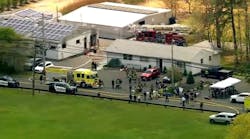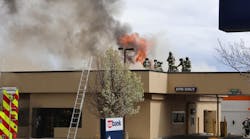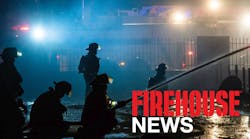Subject: NFPA 1670 Vehicle Rescue, Technician-level Skills and Competencies
Topic: Advanced Hands-on Training Skill: Total Roof Removal, Roof-resting Vehicle
Objective: Given the scenario of a vehicle resting on its roof with an occupant trapped inside, the decision has been made to totally remove the roof. Crews must stabilize the vehicle and complete a total roof removal evolution.
Task: Totally remove the roof of a vehicle while the vehicle is resting on its roof on a level surface.
This University of Extrication column is the sixth and final installment in a multi-part series presenting advanced technician-level vehicle rescue training scenarios. This column describes a rescue challenge that meets the criteria of a technician-level skill and competency of NFPA Standard 1670.
This scenario is based on an incident where a sedan has rolled onto its roof. The driver occupant remains seated and belted, and is now suspended upside-down inside the vehicle. EMS personnel have accessed the patient and are now requesting that the entire roof of the vehicle be removed so the patient can be extricated.
The rescue team has several tasks ahead of them. First, stabilization of the vehicle must be accomplished. After the vehicle is stable, hazards need to be controlled. Then, the vehicle may have to be lifted slightly to take the load off the roof. Once the load is off the roof, the roof-removal process can begin by removing side and rear glass and “disconnecting” the roof from the windshield. Finally, after the roof is removed, the simulated patient can then be extricated. Let’s look at these tasks one at a time.
Stabilization
Stabilization involves taking a roof-resting vehicle and securing it enough that crew members can work in, around and under the vehicle without fear of vehicle movement or collapse. A rollover vehicle is most commonly engine heavy so crews will generally find the engine, windshield, and the portion of the vehicle ahead of the firewall contacting the ground. The rear of the vehicle will be off the ground.
The most efficient stabilization of a roof-resting vehicle is accomplished by use of a tensioned buttress stabilization system. These struts must be strategically placed so that when the roof pillars are cut, there is sufficient room to maneuver the roof out from underneath the vehicle.
In lieu of struts, cribbing can be used although this is less effective and not as safe as with the strut systems. Cribbing blocks are placed on both sides of the vehicle at the base of the A-pillar near the firewall. This area of the vehicle is close to the ground and will not require a lot of cribbing. At the rear C-pillar area, box cribs will be needed. To maintain the stability of the cribbing, the height of the box crib should not go higher than three times the length of the blocks. In other words, using 18-inch-long cribbing, the box crib should not be higher than 4½ feet. As cribbing is stacked higher, it becomes inherently more unstable. Also, the slant of a roof-resting vehicle can make building a solid box crib along the trunk and rear fender area difficult. Once built, keeping the cribbing intact along the rear of the vehicle will also be a challenge.
Lifting
Rescuers may find that a lot of the weight of the vehicle is resting on the roof. This makes access to the front roof and pillar area difficult. The two critical locations to inspect are along the header of the windshield and the front A-pillars. Due to the rollover, they may have collapsed and be directly contacting the ground. Lifting the vehicle slightly can make roof removal a whole lot easier.
Crews can stabilize the vehicle at the rear C-pillar area and apply a lifting force along each side at the firewall area. Do not over lift. Just enough to get the weight off the roof line and the front A-pillar is sufficient.
Roof Removal
Roof removal can be initiated once the vehicle is stable and the load is off the roof. Removal can be accomplished with the same tools and using the same techniques as when the vehicle is upright with only a few changes. The biggest difference with this task compared to a conventional roof removal task is that the crews are removing the roof while the vehicle is upside-down.
When working on a roof-resting vehicle, it may be better to make two cuts instead of one in the pillar, allowing a chunk of it to be removed. In addition, attack the rear-roof pillars first and work forward. Typically, rear pillars are fatter and thicker, and take more effort to cut through. You want the vehicle to be the most stable; with the other pillars intact, stability is the greatest.
Another slight change in the roof-removal task involves figuring out which way the roof will be slid out from underneath the vehicle once all pillars are cut. The roof pillars on the side of the vehicle that must pass under the car should be cut off at the roof line. Being short, they will pass underneath the vehicle without snagging on the seatbacks or the simulated patient.
The roof pillars on the other side of the vehicle can be cut at the door sill/dashboard level. This leaves the most working room as the roof is pulled away from the vehicle.
Total roof removal of a vehicle in this position may never be something you do at an incident. Ironically, some teams have done this at real-world rescues with great success. The point of this evolution is that as a training assignment, any team that can cut the roof off of a roof-resting vehicle has demonstrated competency in vehicle stabilization, excellent teamwork, good command and control, as well as the ability to accomplish total roof removal under unusual circumstances. Rescue personnel are confronted with a situation that they have never run into before. They must use their experience and training to solve a rather unique problem. This is what real rescue is all about!
Task: Totally remove the roof of a vehicle while the vehicle is resting on its roof on a level surface.
Ron Moore will present “University of Extrication: Hybrid Vehicles Update 2005” at Firehouse Expo 2005, July 26-31 in Baltimore.Ron Moore, a Firehouse® contributing editor, is a battalion chief and the training officer for the McKinney, TX, Fire Department. He also authors a monthly online article in the Firehouse.com “MembersZone” and serves as the Forum Moderator for the extrication section of the Firehouse.com website. Moore can be contacted directly at [email protected].





